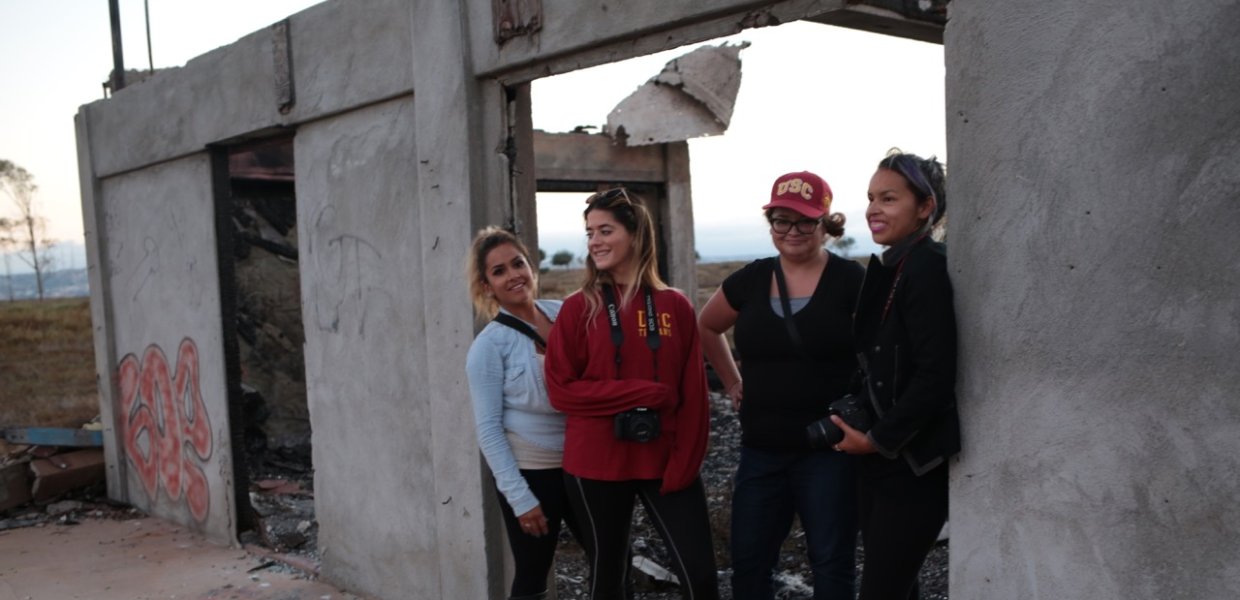In October a group of USC Annenberg students launched a new initiative that uses social media brand to collect and share stories about Latinos in the communities near USC’s campus and beyond.
Named Dímelo, which means “tell me” in Spanish, the project was born out of “Social Media Storytelling for a Latino Audience,” a directed research course taught by professors Amara Aguilar and Laura Castañeda.
“We're working on producing stories about diversity, inclusion and community, specifically for social media,” Aguilar said. “We’re really trying to do something new with our students for the Latino community.”
The first project for Dímelo was “Brownish,” a video for Facebook that explored race and self-identity in a multicultural America.
Barbara Estrada (B.A. Broadcast Journalism ‘17), digital editor for the Dímelo team, said that Annenberg’s young journalists have taken it upon themselves to ensure that USC’s diversity is represented in student media. “USC has one of the largest international student bodies in the country,” she said, “and it is beyond important to have that statistic reflected in our student newsroom through the content created.”
Soon after “Brownish” was published in October, an opportunity arose for students to work with Fusion, the Univision-owned network aimed at English-speaking millennials from diverse backgrounds. Fusion has been looking for student collaborators with whom they could produce content for a younger audience, while Aguilar and Castañeda could not have imagined a better partnership.
“We were looking for these opportunities, and this one just happened to fall into place,” Aguilar said. She had already invited guest speakers from major Latino media organizations for the class, including Azteca America, ABC 7’s Vista L.A. and Huffington Post Latino Voices, so the partnership with Fusion made sense. “They also thought it was a really perfect fit, considering the focus of the class,“ Aguilar said.
Castañeda agreed, adding that since the young Latino demographic has continued to grow across the U.S., and many of them tend to prefer their news in English, working with Fusion and its young and diverse editors “presented a unique opportunity to reach an important audience.”
Six students from the class traveled with Aguilar and Castañeda to San Diego, where they joined editor Alexis Madrigal and the rest of the Fusion team to cover stories that would complement their "RiseUp as One" concert, a celebration of music, diversity and unity at the U.S.-Mexico border. Among them was Juana Lopez (M.S. Journalism ‘17), who said taking advantage of this opportunity was “a no-brainer.”
“Obviously we go to school and get all these experiences, but this is doing it out in the real world, with a well-known company,” Lopez said. “I wanted to get the hands-on experience, get a rundown of their day, and what it looks like as far as coming up with a story.”
For one of her assignments, Lopez hopped on a small plane to shoot footage of the physical U.S.-Mexico border, as seen from a mile up above. “You always hear about the borders, but what does it look like? So we are going to stick a 360 camera under the plane.”
Estrada also joined the Fusion team, taking over their Snapchat account for a day to share videos of the student at work at the border. These included a recounting of Lopez’s trip on the plane, as well as on-the-ground vignettes of street life in Tijuana from Estrada.
Estrada is a firm believer in the power of digital and social media to further the evolution of journalism.
“Digital is the future of journalism,” she said. “News is being broken on social media more and more everyday, but journalism is evolving into different branches online, not just social media.”
Estrada gained valuable experience in professional reporting by assisting and shadowing the Fusion reporters while they pursued stories near the border, including the struggles of Haitian migrants in Tijuana hoping to cross the border into the U.S.
”Being able to obtain insight into creative process of an established media outlet set the tone for the entire trip,” Estrada said. “It was interesting to witness how the pre-production of stories would then develop into the final product.”
Ultimately, the class and the collaboration with Fusion gave the students an important lesson in the importance of diversity and inclusion in journalism.
“Ethnicity/race is just one of those intersections that must always be considered when telling a story,” Estrada said. “By telling the stories that affect the lives of people that don't always get the proper, accurate and necessary amount of coverage, it eliminates all sorts of stereotypes.”
Lopez was especially impressed with the different ethnicities and backgrounds represented in the reporters and staff at Fusion, but understands that it’s not always the case with other media organizations.
“It was nice to see that Fusion actually does that in their staffing—that's what I want to see more of in regular newsrooms,” said Lopez. “We're a melting pot—you should be able to relate to every ethnicity, every gender, and not just towards one specific group. If you want people to hear what you have to say, then make sure that you're targeting every audience.”
Aguilar hopes to offer the class again next semester. “It's a really important program for students and USC Annenberg because it does empower students, and it does focus on diverse storytelling,” she said.
For Estrada, the class is just one step in the right direction for the evolution of journalism. “Although Latinos in the U.S. still continue to fight for a space in America, we have become the new majority,” she said. “And it’s only a matter of time where our TV and mobile screens are going to reflect just that."









